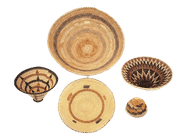Presented by Museum of the Peace Corps Experience and American University Museum
c. 2011–13
Kavango, Namibia
Makalani palm, grasses. dimensions variable
Collection, Museum of the Peace Corps Experience
Gift of Alice Impraim, Namibia, Rundu 2011–13

I have always loved baskets, especially colorful ones. Before my Peace Corps service, I had collected quite a few from Ghana, the country of my birth, and other parts of the world. I viewed my time in Namibia as an opportunity to serve—and to add to my basket collection.
Basket weaving in Kavango has been traced back to the early 1900s, when Namibia was a German colony. The colorful baskets are woven from the makalani palm, along with local grasses that grow in the Kavango region. Basket makers use the traditional coil technique. To obtain the shades of brown, purple, and yellow, colors, palm leaves are prepared and placed in boiling water with bark and roots of various shrubs and trees.
Tradition calls for these baskets to be woven by women in a communal manner as they sit outside their homesteads. Baskets are used for harvesting, winnowing, transporting, and storing grain.
As a Small Business and Entrepreneurship Development (SEED) volunteer, I worked with a group of 15 persons with disabilities—blind, hearing impaired, or missing limbs. My goal was to help them set up a bakery as an income generating project. Fortunately my love for baskets turned out to be a big boost for my bakery project.
My roommate, a Peace Corps Response volunteer, coordinated basket production with a local women’s cooperative known as the Kavango Basket Weavers. She purchased the baskets from the cooperative to sell to trading companies in the United States. I bought and shipped baskets to the US and sold them to my church members, former coworkers, and neighbors in California. Each buyer received a beautiful basket in return for a few dollars, and they knew the money would go to a good cause. I was able to raise enough funds to purchase equipment for the bakery, and the rest was deposited in the bank as a rainy day fund for my friends with disabilities in Namibia.
Today basket weaving continues in the Kavango region, providing jobs and incomes that support hundreds of families—and even whole communities.
The bakery also thrives. And just think: it was my simple love for baskets that brought these ventures together and gave them new vitality.
The Committee for a Museum of the Peace Corps Experience is a 501(c)(3) private nonprofit organization. Tax ID: EIN # 93-1289853
The Museum is not affiliated with the U.S. Peace Corps and not acting on behalf of the U.S. Peace Corps.
Museum of the Peace Corps Experience © 2024. All Rights Reserved.